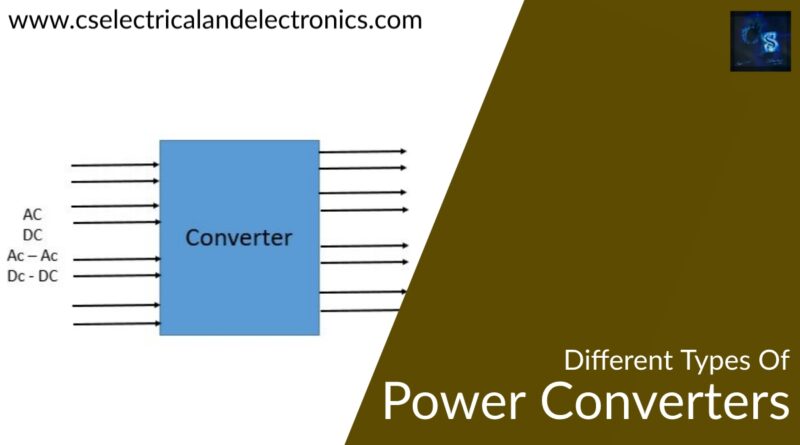Different Types Of Power Converters, AC, DC, DcDc, AcAc Converter
Hello guys, welcome back to my blog. In this article, I will discuss different types of power converters such as uncontrolled rectifiers, controlled rectifiers, cyclo-converter, chopper, ac voltage controllers, inverters.
If you have any doubts related to electrical, electronics, and computer science, then ask questions. You can also catch me on Instagram – CS Electrical & Electronics And Chetan Shidling.
Also, read:
- Top 12 Online Circuit Simulators, Free Online Electronic Circuit Simulators
- What Is Cycloconverter, Working, Types, Benefits, Drawbacks, Applications
- What is Linear Integrated Circuits, Why It is Used, Working & Applications
Different Types Of Power Converters
Nowadays, power converters are used in almost every electronic device. To convert energy from one form to another form, a power converter is required. There are basically six types of power converters.
01. Controlled Rectifier
The purpose of a controlled rectifier is to convert energy from ac supply to dc supply. This is called a controlled rectifier because we can control the output by changing the firing angle of SCR (silicon controlled rectifier). The controlled rectifier consists of SCR (silicon controlled rectifier), SCR will convert supply from ac to dc.
Once the SCR is turned on, by changing the firing angle of SCR, we can control the output. The controlled rectifier is used in any place where you want to control the dc supply. The types of controlled rectifiers are half-wave rectifiers and full-wave rectifiers.
02. Uncontrolled Rectifier
The purpose of an uncontrolled rectifier is to convert energy from ac supply to dc supply. This is called an uncontrolled rectifier because we can not control the output. This circuit consists of diodes that will convert ac supply to dc supply. This circuit is used in the mobile charger, and regulated power supplies. The types of uncontrolled rectifiers are half-wave rectifiers and full-wave rectifiers.
03. Cycloconverters
The purpose of cyclo-converter is to convert fixed frequency into variable frequency. If you want the frequency to vary then you can go for this circuit. This circuit is used to control the speed of the induction motor, by varying frequency.
04. Choppers
The chopper circuit is again classified as a step-up chopper and step-down chopper. The step-up chopper is also called a boost converter and the step-down chopper is also called a buck converter. The chopper is also called a buck-boost converter. If you want to step-down dc supply then go for step-down chopper or buck converter. If you want to step up the dc supply then you go for a step-up chopper or boost converter.
If you want to do both step-up and step-down in one circuit then go for buck-boost converter or chopper. This circuit is used in electric vehicles to supply energy from the battery to the BLDC motor.
05. Inverter
This circuit converts dc supply into ac supply. If you want to convert your battery supply into ac supply then go for the inverter. This circuit is used in the inverter which is used at home. The inverter used for domestic purposes converts the dc supply of the battery into the ac supply.
06. AC Voltage Controller
If you want to vary the ac supply then go for ac voltage controller. The ac voltage controller converts fixed ac voltage into the variable ac voltage. This can also be done using a transformer if you go for power electronics then by using the ac voltage controller, you can vary supply.
These are the different types of power converters. Each converter is used for different applications. Soon, I will publish an article on all converts in detail. I hope this article may help you all a lot. I think bow you have a clear idea of different types of converts. Thank you for reading.
Also read:
- What Is Vector CANoe Tool, Why It Is Used In The Automotive Industry
- What Is TCM, Transmission Control Module, Working, Purpose,
- Driver Monitoring Systems In Vehicles, Working, Driver Sleepy Alert
- Top 100 Automotive Interview Questions With Answers For Engineers
- Autonomous Vehicles: The Future Of Transportation
- Advancements In 3D Printing Technology And It’s Future
- Space Technology: Advancements And Future Exploration
- Advancements In Power Electronics For Energy Efficiency
Author Profile
- Chetu
- Interest's ~ Engineering | Entrepreneurship | Politics | History | Travelling | Content Writing | Technology | Cooking
Latest entries
 All PostsApril 19, 2024What Is Vector CANoe Tool, Why It Is Used In The Automotive Industry
All PostsApril 19, 2024What Is Vector CANoe Tool, Why It Is Used In The Automotive Industry All PostsApril 13, 2024What Is TCM, Transmission Control Module, Working, Purpose,
All PostsApril 13, 2024What Is TCM, Transmission Control Module, Working, Purpose, All PostsApril 12, 2024Top 100 HiL hardware in loop Interview Questions With Answers For Engineers
All PostsApril 12, 2024Top 100 HiL hardware in loop Interview Questions With Answers For Engineers All PostsMarch 22, 2024Driver Monitoring Systems In Vehicles, Working, Driver Sleepy Alert
All PostsMarch 22, 2024Driver Monitoring Systems In Vehicles, Working, Driver Sleepy Alert








